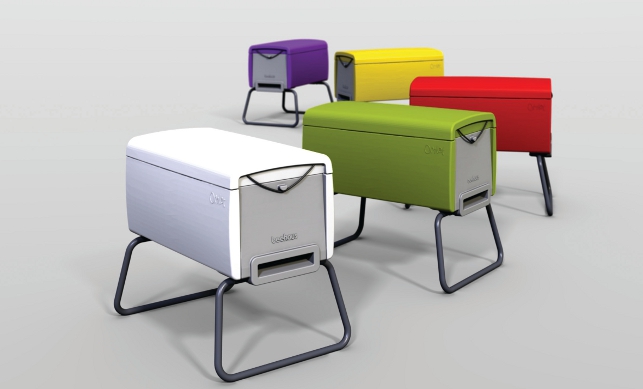Tanya Weaver has joined the crusade to save the honeybee and is about to embark on her beekeeping adventure. But in checking out the tools of the trade, she wonders whether some could do with a redesign
My love of honey almost borders on addiction. I start the day with a teaspoon of raw honey (something my grandmother told me to do and she lived to 97) and end most nights with a cup of warm milk and honey.

The Beehaus, a modern beehive designed and developed by British company Omlet
In between I’ll smear it on toast, swirl it into porridge, drizzle it onto yogurt, spoon into tea or literally just eat it straight out the jar.
But my love of honey has never really extended to bees. It’s nothing personal, but I’d never given much consideration to how hard these little fellows work to actually produce it. I’ve since learnt that an average worker bee produces just 1/12 teaspoon in her lifetime.
But she is just one of a 35,000 strong colony, who in a single day can fly the equivalent distance to the moon. Incredible.
A couple of years back, it hit the headlines that bee colonies were mysteriously collapsing. Colony Collapse Disorder (CCD), first observed in the USA, saw thousands of bees simply disappearing.
As yet no one has a conclusive answer as to why they are dying and so far the deaths have been attributed to stress and disease. To find solutions, organisations worldwide such as the British Beekeepers Association (BBKA), are urging governments to finance research to confront the problems.
As the BBKA states, one in three mouthfuls of the food we eat is dependent on honeybee pollination. This threat of the catastrophic loss of bees has not only driven people to plant beefriendly flowers in their gardens but many have actually joined the beekeeping ranks.
Urban beekeeping has now become quite a phenomenon and in London alone you’ll find bee hives in many a nook and cranny.
I’ve bought Hackney honey before, which is collected from hives located on inner city London rooftops, and I must say it was quite delicious.
So, the more I found out about the plight of the honeybee, the more interested I became in how they carry out their work. For instance, honeycomb is a marvel of engineering that consists of a precise and densely packed matrix of hexagonal cells.
Then there is the bee dance — a unique figure-eight dance performed by a bee when she returns to the hive to communicate to her fellow workers where the best sources of nectar are. I could continue, but I won’t drone on (see what I did there) with all the facts now.
I initially dismissed the idea of keeping my own bees as I don’t really have much of a garden to speak of nor a flat roof.
However, following a one day ‘Beekeeping Appreciation Course’ that I attended last summer (a wedding gift from a friend and no, I didn’t purposely put it on the gift list), I learnt that there are many willing farmers who are more than happy for hives to be placed on a patch of their land.
It got me thinking that I could definitely do this and so enlisted myself on the ‘Introduction to Beekeeping’ course, which commenced at the BBKA’s headquarters from mid January.
Luckily a friend’s father has a smallholding and is happy to be an accomplice in my beekeeping adventure. Now all I need is to complete my course so I’m as well versed in beekeeping as I can be, find a bee colony, get all the kit and I’ll be a fully prepared amateur beekeeper. What a buzz that will be! (sorry).
I’m very excited about my Beehaus, a modern, urban beehive designed by British company Omlet. Mine’s lime green and will arrive in a few weeks.
But I’ve not really taken to the rest of the beekeeping tools. When introduced to them in the most recent session of the course I thought that many could do with a redesign.
The smoker, for instance, which is used to puff smoke onto the bees to calm them down when you are about to take the roof off their house, looks like a contraption from 1850. Then there is the wooden bee brush used to gently sweep the bees out the way when you’ve got inside the hive.
The course instructor explained how the brush tends to cause the bees stress so he demonstrated the grubby goose wing he uses instead. But one of the more amusing tools I thought is the ‘clip queen catcher’, which looks exactly like a woman’s jaw clip hair accessory.
All of this made me think that although most of these tools are functional they probably haven’t changed in the past 30 or more years. I wondered what they could become in the hands of a product designer or engineer. Just like the way Omlet redesigned the beehive with the user in mind – both human and bee.
So, we’ll be launching a competition — DesignBuzz — in the coming weeks. Just imagine, you could be the one who comes up with a better way of puffing smoke onto the bees or even redesigning the bee suit so a beekeeper doesn’t have to look like an astronaut about to embark on a moon landing. It could bee fun. 
Tanya Weaver wonders whether some beekeeping tools could do with a redesign
Default







